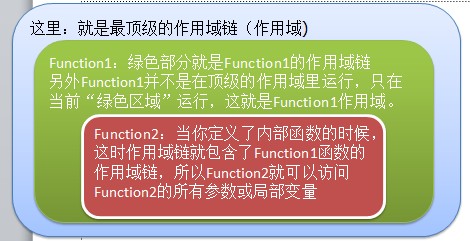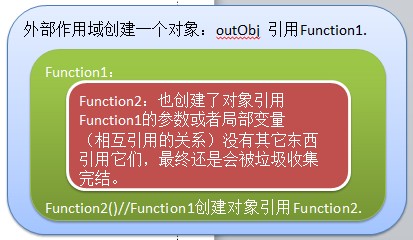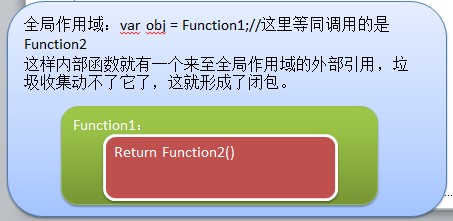 Web Front-end
Web Front-end
 JS Tutorial
JS Tutorial
 JavaScript Advanced Chapter: Closures, Simulation Classes, Inheritance (5)_javascript skills
JavaScript Advanced Chapter: Closures, Simulation Classes, Inheritance (5)_javascript skills
JavaScript Advanced Chapter: Closures, Simulation Classes, Inheritance (5)_javascript skills
1. Closures in JavaScript
1. Let’s first understand what the scope of a function is.

2. Called object

Combination example:
function display( something)
{
function executeDisplay1()
{
document.write("I am helping the boss print:" something "
");//something that refers to an external function Parameters
}
executeDisplay1();//Function display refers to the internal function
}
display("sorry");//After execution, it is recycled by the garbage collector
3. Formation of closure

Example 1,
var obj = {};//Global object
function buyHouse(price,area)
{
return function(){return "The price you want to pay:" price*area;}; //Put the internal Function as return value
}
obj.people = buyHouse(12000,80); //Save the reference of the internal function into the people attribute of the obj object.
//This forms a closure, a simple expression: save the reference of the nested function in the global scope, whether you use the value it returns, or store it in the properties of the object.
document.write(obj.people() "
");
Example 2,
function add()
{
var number = 0;
return function(){return number;} ;//
}
var num = add();//Now there are 4 references, right? The first one is globally created: access function, and the second one has external function (here refers to Add( ) refers to the anonymous function)
//The third one is the anonymous function (that is, the return function... refers to the local variable of Add), and the fourth one is the global object (var num).
//The object of each call to the global object is still saved in the function body, so the values of local variables will be maintained.
document.write(num());
//Equivalent method
num2 = (function(){var number = 0;return function(){return number;}}) ();//Anonymous function, directly assigned to the global object
document.write(num2());
Example 3, implementing private attributes
//Use closures to implement private properties
function createProperty(o,propertyname,check)
{
var value;
o["get" propertyname] = function(){return value;};//Return an anonymous function body to the object's property
o["set" propertyname] = function(v){if(check && !check)//Check the legality of the parameters throw("The parameter is incorrect!");
else value = v; };//Return an anonymous function body Properties for the object
}
var o = {};
createProperty(o,"Age",function(x){return typeof x == "number";});//followed by An anonymous function that performs verification work and returns false if it is not a number
o.setAge(22); //Use the properties of the object
document.write(o.getAge());
//In fact, the function is saved in the properties of the global object.
2. Classes in JavaScript
Let’s also start with some basic terms!
1. Prototype
In fact, the prototype of an object is the prototype value of the constructor. All functions have a prototype attribute. When the function is created, it is automatically created and initialized. Initialize it The value is an object. This object has a property called constructor, which points back to the constructor associated with the prototype.
function PeopleHope(money,house)
{
this.money = money;
this.house = house;
}
PeopleHope.prototype.hope = function( ){document.write("I want to own money and a house");};//This is the prototype, which will be initialized into the properties of the object by the constructor.
for(var p in PeopleHope.prototype)
{
document.write("The prototype is out! t " p "
");//Output: The prototype is out ! hope
}
2. Simulation class
In fact, the "class" in Javascript is just a function. Just jump into the code!
function PeopleHope(money,house)
{
this.money = money;
this.house = house;
PeopleHope.VERSION = 0.1//Attributes of the class
PeopleHope.createLive = function(){document.write("In the leadership of the party Next, our life is very good! ");}//Class methods must be direct references to the class
}
3. Class inheritance
function CreateClass(name,version)
{
this.name = name; //Initialization Object attribute
this.version= version;
CreateClass.AUTHOR = "Frank";//Class attribute
CreateClass.SellHouse = function(){document.write("We are the leading real estate company Vanke") ;};//Class method
CreateClass.prototype.Company = "vanke";
CreateClass.prototype.HousePrice = function(){document.write("A luxury home on the top of Dameisha sold for 50 million , best-selling price! ");};
//Prototype, in fact, you may ask at this point, what is the difference between this prototype and class methods?
//Actually: For example, var o = new CreateClass("COFCO Real Estate", "Phase 1"); this in the CreateClass function is o, and together it is
//o.name = "COFCO Real Estate" ";o.version = "Issue 1";Here!
//As for what the prototype is actually doing, you can think of it as a "traitor". When you create the object o, the prototype tells the constructor to take away the initialization together
//It becomes the object o property.
}
function House(name,version,city)
{
CreateClass.apply(this,[name,version]);//Inherited constructor
this.city = city;
House.prototype.housename = "Peninsula Garden";
}
House.prototype = new CreateClass("COFCO Real Estate", "Phase II");//Get the CeateClass attribute through new, including the prototype object
//Print the prototype attribute of the function
function displayPrototype(c)
{
for(var x in c.prototype)
{
document.write(x "
");
}
}
displayPrototype(House);//Output: HousePrice Company name version
//Delete objects that are not prototypes
delete House.prototype.name; //Delete
delete House.prototype.version; //Delete
displayPrototype(House); //Output: HousePrice Company
var customers = new House("Peninsula Garden","Phase Three"," West pull teeth");
for(var t in customers)
{
if(typeof customers[t] == "function")//Determine whether it is a function
{
customers[ t]();//Execute
continue;//Return this time and proceed to the next cycle
}
document.write(t ":t" customers[t] "
");
// Output housename: Peninsula Garden Company: vanke A mansion on the top of Dameisha sold for 50 million yuan, a best-selling price! name: Peninsula Garden version: Phase 3 city: Xijia
//Inheritance is realized. Through prototypes.
Summary: I will share this article with you here. Originally, there was a namespace to share. Due to the learning schedule, I will share the Javascript syntax here!
Next time I will share my programming of javascript client and advanced applications such as Jquery.

Hot AI Tools

Undresser.AI Undress
AI-powered app for creating realistic nude photos

AI Clothes Remover
Online AI tool for removing clothes from photos.

Undress AI Tool
Undress images for free

Clothoff.io
AI clothes remover

AI Hentai Generator
Generate AI Hentai for free.

Hot Article

Hot Tools

Notepad++7.3.1
Easy-to-use and free code editor

SublimeText3 Chinese version
Chinese version, very easy to use

Zend Studio 13.0.1
Powerful PHP integrated development environment

Dreamweaver CS6
Visual web development tools

SublimeText3 Mac version
God-level code editing software (SublimeText3)

Hot Topics
 Detailed explanation of C++ function inheritance: How to use 'base class pointer' and 'derived class pointer' in inheritance?
May 01, 2024 pm 10:27 PM
Detailed explanation of C++ function inheritance: How to use 'base class pointer' and 'derived class pointer' in inheritance?
May 01, 2024 pm 10:27 PM
In function inheritance, use "base class pointer" and "derived class pointer" to understand the inheritance mechanism: when the base class pointer points to the derived class object, upward transformation is performed and only the base class members are accessed. When a derived class pointer points to a base class object, a downward cast is performed (unsafe) and must be used with caution.
 What is the meaning of closure in C++ lambda expression?
Apr 17, 2024 pm 06:15 PM
What is the meaning of closure in C++ lambda expression?
Apr 17, 2024 pm 06:15 PM
In C++, a closure is a lambda expression that can access external variables. To create a closure, capture the outer variable in the lambda expression. Closures provide advantages such as reusability, information hiding, and delayed evaluation. They are useful in real-world situations such as event handlers, where the closure can still access the outer variables even if they are destroyed.
 How to implement closure in C++ Lambda expression?
Jun 01, 2024 pm 05:50 PM
How to implement closure in C++ Lambda expression?
Jun 01, 2024 pm 05:50 PM
C++ Lambda expressions support closures, which save function scope variables and make them accessible to functions. The syntax is [capture-list](parameters)->return-type{function-body}. capture-list defines the variables to capture. You can use [=] to capture all local variables by value, [&] to capture all local variables by reference, or [variable1, variable2,...] to capture specific variables. Lambda expressions can only access captured variables but cannot modify the original value.
 What are the advantages and disadvantages of closures in C++ functions?
Apr 25, 2024 pm 01:33 PM
What are the advantages and disadvantages of closures in C++ functions?
Apr 25, 2024 pm 01:33 PM
A closure is a nested function that can access variables in the scope of the outer function. Its advantages include data encapsulation, state retention, and flexibility. Disadvantages include memory consumption, performance impact, and debugging complexity. Additionally, closures can create anonymous functions and pass them to other functions as callbacks or arguments.
 How do inheritance and polymorphism affect class coupling in C++?
Jun 05, 2024 pm 02:33 PM
How do inheritance and polymorphism affect class coupling in C++?
Jun 05, 2024 pm 02:33 PM
Inheritance and polymorphism affect the coupling of classes: Inheritance increases coupling because the derived class depends on the base class. Polymorphism reduces coupling because objects can respond to messages in a consistent manner through virtual functions and base class pointers. Best practices include using inheritance sparingly, defining public interfaces, avoiding adding data members to base classes, and decoupling classes through dependency injection. A practical example showing how to use polymorphism and dependency injection to reduce coupling in a bank account application.
 The impact of function pointers and closures on Golang performance
Apr 15, 2024 am 10:36 AM
The impact of function pointers and closures on Golang performance
Apr 15, 2024 am 10:36 AM
The impact of function pointers and closures on Go performance is as follows: Function pointers: Slightly slower than direct calls, but improves readability and reusability. Closures: Typically slower, but encapsulate data and behavior. Practical case: Function pointers can optimize sorting algorithms, and closures can create event handlers, but they will bring performance losses.
 Detailed explanation of C++ function inheritance: How to debug errors in inheritance?
May 02, 2024 am 09:54 AM
Detailed explanation of C++ function inheritance: How to debug errors in inheritance?
May 02, 2024 am 09:54 AM
Inheritance error debugging tips: Ensure correct inheritance relationships. Use the debugger to step through the code and examine variable values. Make sure to use the virtual modifier correctly. Examine the inheritance diamond problem caused by hidden inheritance. Check for unimplemented pure virtual functions in abstract classes.
 How are closures implemented in Java?
May 03, 2024 pm 12:48 PM
How are closures implemented in Java?
May 03, 2024 pm 12:48 PM
Closures in Java allow inner functions to access outer scope variables even if the outer function has exited. Implemented through anonymous inner classes, the inner class holds a reference to the outer class and keeps the outer variables active. Closures increase code flexibility, but you need to be aware of the risk of memory leaks because references to external variables by anonymous inner classes keep those variables alive.





